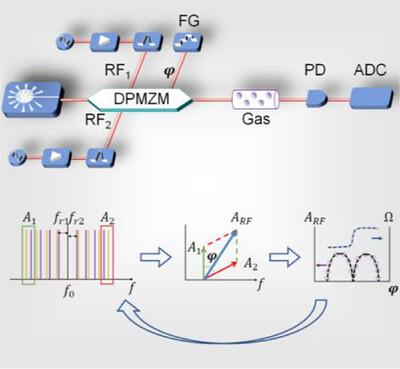使用一个调制器的双向带电光双梳光谱
IF 10
1区 物理与天体物理
Q1 OPTICS
引用次数: 0
摘要
电光双梳光谱学为传统的锁模激光方法提供了一种具有吸引力和灵活性的替代方案,并且具有在光子集成芯片上实现的独特潜力。然而,尽管最近在简化EO双梳结构方面做出了努力,例如使用更少的调制器,但光学滤波器或声光调制器(AOMs)仍然难以在芯片上实现,这对于解决EO梳中的图像频率问题是必不可少的。本文提出了一种简单的EO双梳光谱方案,该方案只使用一个现成的调制器,不使用光学滤波器或aom,同时充分利用了产生的梳的带宽。在该方案中,两个具有不同梳间距的宽带驱动信号被施加到调制器臂上,并通过变偏置调谐双梳之间的相位。然后使用不同相位偏置下的干涉图来区分图像频率处的振幅。在低成本和紧凑的射频梳状发生器的驱动下,实现了具有200多个分辨梳齿的EO双梳状光谱的演示。该方案通过利用双向带EO梳状频谱,简化了EO设置并提高了功率效率。它可以是一个具有吸引力的芯片集成和成本效益的双梳器件解决方案。本文章由计算机程序翻译,如有差异,请以英文原文为准。

Double-Sideband Electro-Optic Dual-Comb Spectroscopy Using One Modulator
Electro-optic (EO) dual-comb spectroscopy offers an attractive and flexible alternative to the traditional mode-locked laser approach, and has the unique potential to be implemented on photonic integrated chips. However, despite recent efforts on simplifying EO dual-comb configurations, such as using fewer modulators, optical filters or acousto-optic modulators (AOMs) that are still difficult to realize on chips have been indispensable to resolving the image frequency issue in EO combs. Here, a simple EO dual-comb spectroscopy scheme is proposed, which uses only one off-the-shelf modulator and no optical filters or AOMs while the bandwidth of the generated combs is fully utilized. In the scheme, two broadband driving signals with different comb spacings are applied to the modulator's arms, and the phase between the dual combs is tuned via a varying bias. The amplitudes at the image frequencies are then distinguished using interferograms under different phase biases. Demonstration of EO dual-comb spectroscopy with over 200 resolved comb teeth is achieved, driven by low-cost and compact RF comb generators. The scheme simplifies the EO setup and boosts power efficiency by leveraging the double-sideband EO comb spectra. It can be an attractive enabling solution of chip-integrated and cost-effective dual-comb devices.
求助全文
通过发布文献求助,成功后即可免费获取论文全文。
去求助
来源期刊
CiteScore
14.20
自引率
5.50%
发文量
314
审稿时长
2 months
期刊介绍:
Laser & Photonics Reviews is a reputable journal that publishes high-quality Reviews, original Research Articles, and Perspectives in the field of photonics and optics. It covers both theoretical and experimental aspects, including recent groundbreaking research, specific advancements, and innovative applications.
As evidence of its impact and recognition, Laser & Photonics Reviews boasts a remarkable 2022 Impact Factor of 11.0, according to the Journal Citation Reports from Clarivate Analytics (2023). Moreover, it holds impressive rankings in the InCites Journal Citation Reports: in 2021, it was ranked 6th out of 101 in the field of Optics, 15th out of 161 in Applied Physics, and 12th out of 69 in Condensed Matter Physics.
The journal uses the ISSN numbers 1863-8880 for print and 1863-8899 for online publications.

 求助内容:
求助内容: 应助结果提醒方式:
应助结果提醒方式:


